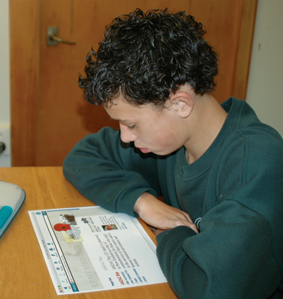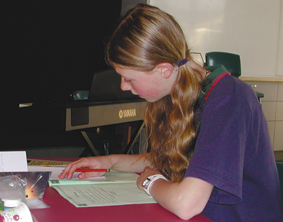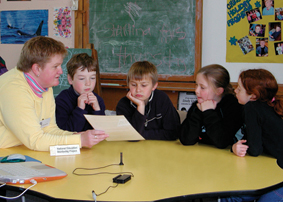| Although
national monitoring has been designed primarily to present an overall
national picture of student achievement, there is some provision for
reporting on performance differences among subgroups of the sample.
Eight demographic variables are available for creating subgroups, with
students divided into subgroups on each variable, as detailed in Chapter
1.
Analyses of the relative performance of subgroups used the total score
for each task, created as described in Chapter
1.
 |
Five of the
demographic variables related to the schools the students attended.
For these five variables, statistical significance testing was used
to explore differences in task performance among the subgroups.
Where only two subgroups were compared (for School Type), differences
in task performance between the two subgroups were checked for statistical
significance using t-tests. Where three subgroups were compared,
one-way analysis of variance was used to check for statistically
significant differences among the three subgroups.
Because the number of students included in each analysis was quite
large (approximately 450), the statistical tests were quite sensitive
to small differences. To reduce the likelihood of attention being
drawn to unimportant differences, the critical level for statistical
significance for tasks reporting results for individual students
was set at p = .01 (so that differences this large or larger among
the subgroups would not be expected by chance in more than one percent
of cases). For tasks administered to teams or groups of students,
p = .05 was used as the critical level to compensate for the smaller
numbers of cases in the subgroups.
For the first four of the five school variables, statistically significant
differences among the subgroups were found for less than 11 percent
of the tasks for both year 4 and year 8. For the remaining variable,
statistically significant differences were found on more than half
of the tasks at both levels. In the detailed report below, all “differences”
mentioned are statistically significant (to save space, the words
“statistically significant” are omitted). |
Results were compared from students in large, medium-sized and small
schools (exact definitions were given in Chapter
1).
For year 4 students, there was a difference among the three subgroups
on one of the 30 tasks, with students from small schools scoring lowest
on Link Task 19 (p45). There were no differences on questions of the
Information Skills Survey (p47).
For year 8 students, there were no differences on any of the 46 tasks,
or on questions of the Information
Skills Survey.
Results
were compared for students living in communities containing over
100,000 people (main centre), communities containing 10,000 to 100,000
people (provincial city) and communities containing less than 10,000
people (rural areas).
For year 4 students, there were differences among the three subgroups
on two of the 30 tasks. Students from the main centres scored highest
on Breakdancing
and lowest on Library
Search. There were no differences on questions of the
Information Skills Survey.
For year 8 students, there were no differences on any of the 46
tasks, or on questions of the Information
Skills Survey. |
 |
Results were compared for year 8 students attending full primary and
intermediate (or middle) schools. There were no differences between
these two subgroups on any of the 46 tasks, or on questions of the
Information Skills Survey.
This year, for the first time, the NEMP samples included enough year
8 students attending year 7 to 13 high schools to permit comparisons
between them and students attending intermediate schools. There were
statistically significant differences (p < .01) on three of the 40
tasks attempted by individual students. Students from year 7 to 13 high
schools scored higher on Hens,
Atlas Y8 and Please,
Mum!. There were no differences on questions of the Information
Skills Survey.
Results achieved by students from Auckland, the rest of the North Island,
and the South Island were compared.
For year 4 students, there were differences among the three sub-groups
on one of the 30 tasks. Students from the rest of the North Island (excluding
Auckland) scored highest on Library
Search. There were no differences on questions of the Information
Skills Survey.
For year 8 students, there were differences among the three subgroups
on five of the 46 tasks: students from the South Island scored highest
on Link Tasks 1, 2 and 3, City
Mountains, and Please,
Mum!. There were no differences on questions of the
Information Skills Survey.
| Socio-Economic
Index |
[ top | back ] |
 |
Schools are
categorised by the Ministry of Education based on census data for
the census mesh blocks where children attending the schools live.
The resulting index takes into account household income levels and
categories of employment. It uses 10 subdivisions, each containing
10 percent of schools (deciles 1 to 10). For our purposes, the bottom
three deciles (1-3) formed the low decile group, the middle four
deciles (4-7) formed the medium decile group, and the top three
deciles (8-10) formed the high decile group. Results were compared
for students attending schools in each of these three decile groups.
For year 4 students, there were differences among the three subgroups
on 17 of the 30 tasks, spread across the three task chapters. Because
of the number of tasks showing differences, they are not listed
here. Students in high decile schools performed better than students
in low decile schools on all 17 tasks, usually with larger gaps
between low and medium decile schools than between medium and high
decile schools. There was also a difference on one question of the
Information Skills Survey:
students from low decile schools were most positive about hunting
for information (question 5)
For year 8 students, there were differences among the three subgroups
on 25 of the 46 tasks, spread across the three task chapters but
including 16 of the 21 year 8 tasks in Chapter 4. Because of the
number of tasks showing differences, they are not listed here. Students
in high decile schools performed better than students in low decile
schools on all 25 tasks, usually with larger gaps between low and
medium decile schools than between medium and high decile schools.
There was also a difference on one question of the Information
Skills Survey: students from low decile schools were most
positive about writing down what they found out (question 8). |
Three demographic variables related to the students themselves:
• Gender: boys and girls
• Ethnicity: Mäori, Pasifika and Pakeha (this
term was used for all other students)
• Language used predominantly at home: English
and other.
During the previous cycle of the Project (1999–2002), special
supplementary samples of students from schools with at least 15 percent
Pasifika students enrolled were included. These allowed the results
of Pasifika students to be compared with those of Mäori and Pakeha
students attending these schools. By 2002, with Pasifika enrolments
having increased nationally, it was decided that from 2003 onwards a
better approach would be to compare the results of Pasifika students
in the main NEMP samples with the corresponding results for Mäori
and Pakeha students. This gives a nationally representative picture,
with the results more stable because the numbers of Mäori and Pakeha
students in the main samples are much larger than their numbers previously
in the special samples.
 The
analyses reported compare the performances of boys and girls, Pakeha
and Mäori students, Pakeha and Pasifika students, and students
from predominantly English-speaking and non-English-speaking homes. The
analyses reported compare the performances of boys and girls, Pakeha
and Mäori students, Pakeha and Pasifika students, and students
from predominantly English-speaking and non-English-speaking homes.
For each of these three comparisons, differences in task performance
between the two subgroups are described using “effect sizes”
and statistical significance.
For each task and each year level, the analyses began with a t-test
comparing the performance of the two selected subgroups and checking
for statistical significance of the differences. Then the mean score
obtained by students in one subgroup was subtracted from the mean score
obtained by students in the other subgroup, and the difference in means
was divided by the pooled standard deviation of the scores obtained
by the two groups of students. This computed effect size describes the
magnitude of the difference between the two subgroups in a way that
indicates the strength of the difference and is not affected by the
sample size. An effect size of +.30, for instance, indicates that students
in the first subgroup scored, on average, three tenths of a standard
deviation higher than students in the second subgroup.
For each pair of subgroups at each year level, the effect sizes of all
available tasks were averaged to produce a mean-effect size for the
curriculum area and year level, giving an overall indication of the
typical performance difference between the two subgroups.
Results achieved by male and female students were compared using the
effect-size procedures.
For year 4 students, the mean-effect size across the 24 tasks was 0.14
(girls averaged 0.14 standard deviations higher than boys). This difference
is small. There were statistically significant (p < .01) differences
favouring girls on 6 of the 24 tasks: Hens,
Link Task 3, Bats,
Link Task 8, Oh
Pussy Cat, Pussy Cat! and Link
Task 16. There was also a difference on one question of the
Information Skills Survey:
girls were more positive than boys about writing down what they found
out (question 8).
For year 8 students, the mean-effect size across the 40 tasks was 0.27
(girls averaged 0.27 standard deviations higher than boys): a moderate
difference. There were statistically significant differences on 24 of
the 40 tasks, with girls performing better on all 24 tasks, spread across
the three task chapters. Because of the number of tasks showing differences,
they are not listed here. There were also differences on five of the
eight questions of the Information
Skills Survey. Girls reported that they more often had a really
interesting study for which they had to find information (question 2)
and more often voluntarily looked up information (question 3). Girls
also were more positive about hunting for information (question 5),
about how good they thought they were at hunting for information (question
6), and about how much they liked writing down what they found out (question
8).
Results achieved by Mäori, Pasifika and Pakeha (all other) students
were compared using the effect-size procedures. First, the results for
Pakeha students were compared to those for Mäori students. Second,
the results for Pakeha students were compared to those for Pasifika
students.
| Pakeha-Mäori
Comparisons |
[ top | back ] |
For
year 4 students, the mean-effect size across the 24 tasks was 0.36 (Pakeha
students averaged 0.36 standard deviations higher than Mäori students).
This is a moderate difference. There were statistically significant
differences (p <. 01) on 17 of the 24 tasks, spread across the three
task chapters. Pakeha students scored higher than Mäori students
on all 17 tasks. Because of the number of tasks showing differences,
they are not listed here. There were no differences on questions of
the Information Skills Survey.
For year 8 students, the picture was similar. The mean-effect size across
the 40 tasks was 0.27 (Pakeha students averaged 0.27 standard deviations
higher than Mäori students). This is a moderate difference. There
were statistically significant differences on 18 of the 40 tasks, spread
across the three task chapters. Pakeha students scored higher than Mäori
students on all 18 tasks. Because of the number of tasks showing differences,
they are not listed here. There were no differences on questions of
the Information Skills Survey.
| Pakeha-Pasifika
Comparisons |
[ top | back ] |
Readers should note that only 30 to 45 Pasifika students were included
in the analysis for each task. This is lower than normally preferred
for NEMP subgroup analyses, but has been judged adequate for giving
a useful indication, through the overall pattern of results, of the
Pasifika students’ performance. Because of the relatively small
numbers of Pasifika students, p = .05 has been used here as the critical
level for statistical significance.
For year 4 students, the mean-effect size across the 24 tasks was 0.37
(Pakeha students averaged 0.37 standard deviations higher than Pasifika
students). This is a moderate difference. There were statistically significant
differences on 14 of the 24 tasks, spread across the three task chapters.
Pakeha students scored higher on all 14 tasks. Because of the number
of tasks showing differences, they are not listed here. There was also
a difference on one question of the Information
Skills Survey: Pasifika students reported having to find information
for a study more frequently (question 1).
For year 8 students, the mean-effect size across the 40 tasks was 0.46
(Pakeha students averaged 0.46 standard deviations higher than Pasifika
students). This is a large difference. There were statistically significant
differences on 29 of the 40 tasks, spread across the three task chapters,
but including all tasks in Chapter 3. Pakeha students scored higher
on all 29 tasks. Because of the number of tasks showing differences,
they are not listed here. There were also differences on four questions
of the Information Skills Survey.
Pasifika students reported having to find information for a study more
frequently (question 1) and more often voluntarily looking up information
(question 3). They also were more positive about hunting for information
(question 5), and about how much they liked writing down what they found
out (question 8).
Results
achieved by students who reported that English was the predominant language
spoken at home were compared, using the effect-size procedures, with
the results of students who reported predominant use of another language
at home (most commonly an Asian or Pasifika language). Because of the
relatively small numbers in the “other language” group,
p = .05 has been used here as the critical level for statistical significance.
For year 4 students, the mean-effect size across the 24 tasks was 0.16
(students for whom English was the predominant language at home averaged
0.16 standard deviations higher than the other students). This is a
small difference. There were statistically significant differences on
three of the 24 tasks: students for whom English was the predominant
language spoken at home scored higher on Link
Task 1, Atlas Y4
and Oh Pussy Cat, Pussy Cat!.
There was also a difference on one question of the Information
Skills Survey. Students whose predominant language at home
was not English reported that they more often had a really interesting
study for which they had to find information (question 2).
For year 8 students, the mean-effect size across the 40 tasks was 0.18
(students for whom English was the predominant language at home averaged
0.18 standard deviations higher than the other students). This is a
small difference. There were statistically significant differences on
16 of the 40 tasks: students for whom English was the predominant language
spoken at home scored lower on Link
Task 14, but higher on the other 15 tasks, spread across the
three task chapters. Because of the number of tasks showing differences,
they are not listed here. There were also differences on four questions
of the Information Skills Survey.
Students whose predominant language at home was not English reported
that they more often voluntarily looked up information (question 3).
They also were more positive about hunting for information (question
5), about how good they thought they were at hunting for information
(question 6), and about how much they liked writing down what they found
out (question 8)
| Summary,
with Comparisons to Previous Information Skills Assessments |
[ top | back ] |
 School
type (full primary, intermediate, or year 7 to 13 high school), school
size, community size and geographic zone did not seem to be important
factors predicting achievement on the information skills tasks. The
same was true for the 2001 and 1997 assessments. However, there were
statistically significant differences in the performance of students
from low, medium and high decile schools on 57 percent of the tasks
at year 4 level (compared to 43 percent in 2001 and 81 percent in 1997)
and 54 percent of the tasks at year 8 level (compared to 71 percent
in 2001 and 56 percent in 1997). School
type (full primary, intermediate, or year 7 to 13 high school), school
size, community size and geographic zone did not seem to be important
factors predicting achievement on the information skills tasks. The
same was true for the 2001 and 1997 assessments. However, there were
statistically significant differences in the performance of students
from low, medium and high decile schools on 57 percent of the tasks
at year 4 level (compared to 43 percent in 2001 and 81 percent in 1997)
and 54 percent of the tasks at year 8 level (compared to 71 percent
in 2001 and 56 percent in 1997).
For the comparisons of boys with girls, Pakeha with Mäori, Pakeha
with Pasifika students, and students for whom the predominant language
at home was English with those for whom it was not, effect sizes were
used. Effect size is the difference in mean (average) performance of
the two groups, divided by the pooled standard deviation of the scores
on the particular task. For this summary, these effect sizes were averaged
across all tasks.
Year 4 girls averaged slightly higher than boys, with a mean effect
size of 0.14 (compared to 0.06 in 2001). Year 8 girls averaged moderately
higher than boys, with a mean effect size of 0.27 (compared to 0.15
in 2001). As was also true in 2001, the Information
Skills Survey results at both year levels showed some evidence
that girls were more positive than boys about information skills activities.
Pakeha students averaged moderately higher than Mäori students,
with mean effect sizes of 0.36 for year 4 students and 0.27 for year
8 students (the corresponding figures in 2001 were 0.25 and 0.39).
Year 4 Pakeha students averaged moderately higher than Pasifika students,
with a mean effect size of 0.37 (compared to 0.40 in 2001). Year 8 Pakeha
students averaged substantially higher than Pasifika students, with
a mean effect size of 0.48 (compared to 0.46 in 2001). The
Information Skills Survey results showed that Pasifika students
were more involved in and enthusiastic about some aspects of information
skills.
Compared to students for whom the predominant language at home was English,
students from homes where other languages predominated averaged slightly
lower, with mean effect sizes of 0.16 for year 4 students and 0.18 for
year 8 students. Comparative figures are not available for the assessments
in 2001.
|



 The
analyses reported compare the performances of boys and girls, Pakeha
and Mäori students, Pakeha and Pasifika students, and students
from predominantly English-speaking and non-English-speaking homes.
The
analyses reported compare the performances of boys and girls, Pakeha
and Mäori students, Pakeha and Pasifika students, and students
from predominantly English-speaking and non-English-speaking homes. School
type (full primary, intermediate, or year 7 to 13 high school), school
size, community size and geographic zone did not seem to be important
factors predicting achievement on the information skills tasks. The
same was true for the 2001 and 1997 assessments. However, there were
statistically significant differences in the performance of students
from low, medium and high decile schools on 57 percent of the tasks
at year 4 level (compared to 43 percent in 2001 and 81 percent in 1997)
and 54 percent of the tasks at year 8 level (compared to 71 percent
in 2001 and 56 percent in 1997).
School
type (full primary, intermediate, or year 7 to 13 high school), school
size, community size and geographic zone did not seem to be important
factors predicting achievement on the information skills tasks. The
same was true for the 2001 and 1997 assessments. However, there were
statistically significant differences in the performance of students
from low, medium and high decile schools on 57 percent of the tasks
at year 4 level (compared to 43 percent in 2001 and 81 percent in 1997)
and 54 percent of the tasks at year 8 level (compared to 71 percent
in 2001 and 56 percent in 1997).